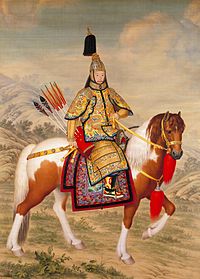Well, it would be better if there was a map for China / Korea area, but let's do the historical reasearch first.
Historical background
Machuria is what is today North eastern China and parts of the Russian east coast. it is in proximity to Korea / China / Mongolia / Siberia. a region largely untamed relative to their Chinese and Korean neighbors, but also a lot more suited for argiculture than the Mongolian plains (it is in fact, one of the largest argiculture zone in modern day China)
While Machuria has entered in and out thoughout Chinese history . it didn't become a major regional player until the 10th century after the collapse of the Mighty Tang Dynasty of China. it was right at after the Tang collapsed that the Khitan people formed the Liao dynasty based out of Machuria.
The Liao took advantage of China's weakened state, exchanging military aid for financial returns and eventually land (including the North Eastern section of the great wall, the major Chinese cities in the from Beijing all the way to the Yellow river had virtually no defense against them) which gave them a major strategic advantage against the later Chinese Song dynasties. which ended up paying major tributes to them throughout most of their existences.
By the early 12 century though, the tide begin to turn against the Liao, as the Jurchen people from deeper parts of Machuria begin to rise up agaisnt them, seeing their opportunity to rid themself of an major financial and stratigical problem, the Song allied themself with the Jurchens and together they launched a 2 way offensive against the Liao. the Song army was defeated at the great wall, but the Jurchens managed to annihilate the Liao forces and take their capital, the Liao dynasty disentergrated , with a good portion of their people fleeing west and founding the Kara-Khitan Khanate that would go on being a major player until some Genghgis Khan dude showed up.
The Jurchens declared themself the Jin dynasty after their conquest of Liao, and realizing that the Song army had also been devastated recently and they hold great strategic positioning against them, they soon launched an offensive against the Song, rushing strait foward to seige the Song Capital of Kei Feng (one of the largest cities in the world at the time) Kei Feng was poorly positioned for defense, as it was basically right on the open Yellow River plains. however the Song also had a large arse army and the walls of KeiFeng were some of the best of it's days. and the Song managed to hold out against the Jin invansion in it's first going.
Then internal dumbness killed the Song dynasty as jelous rivals ousted the Officer that organzed the defense and they sued for peace with the Jin . only to realize that the demands were completely unrealistic, the Jin seeing the internal disorganization of the Song, launched another offensive and this time the Emperor put a complete amature in charge of defense, the results were predictable. as the Song army and the majority of it's officers and the Emperor and his father were captured . the new power in China has formed. teh Jin dynasty.
The Song however, survied in the South thanks to valient defense of various talented (albeit often mavrick) generals and the utilizing of the many Riverways in the south to their advantage. (where the Jin cavalry were made much less effective).
The stalemate held for a couple more century until the Mongols came in and killed everyone in the area. after the collapse of the Jin, the remaining Jurchens fled back to Machuria, where they would be subjects of the Mongol Yuan dynasty, and after that the Ming dynasty.
By the later parts of the Ming dynasty though, the Ming's own coruption and their endless struggles against teh Mongols open up new opportunities for the various tribes of the North East. and in this time Nurhachi was born.
Nurhachi was born in 1558, the grandson of a local Jurchen Tribe leader. he worked under the Ming administrator send to oversee the area. (to keep them from going independent was his real objective). however in the handling of various tribal disputes Nurhachi's grandfather and father were both killed in one incident in 1582. leaving the then 24 year old Nurhachi as the leader of the tribe.
He set off on his ambition almost immediately, first forging an small alliance between several closer tribes and attacking the tribes that killed his father / grandfather. he spent most of the next 4 decades abosorbing other Jurchen clans into his ever growing alliance, until he was the Khan of Machuria. during this time though, he was still wokring as a vassal for the Ming, and even offered aid against the Japanese invasion during the Imjin war. however he was declined, and ended up only fighting a few minor skrimish against the Japanese near the river of Yialue.
By 1618, he offically rebelled against the Ming dynasty and started what was the begining of the end for the Ming.
However, his war against the Ming was hardly a easy process, as in 1626 the last great Ming general, Yuan Chun Huan defeated him in battle, Nurhachi himself was wounded and died two years later .
His son Hong Tai Ji though, would continue his legacy, going on to forming an alliance with the Mongols and eventually all of China, forging the last imperial dynasty of China, the Qing.









 Reply With Quote
Reply With Quote










